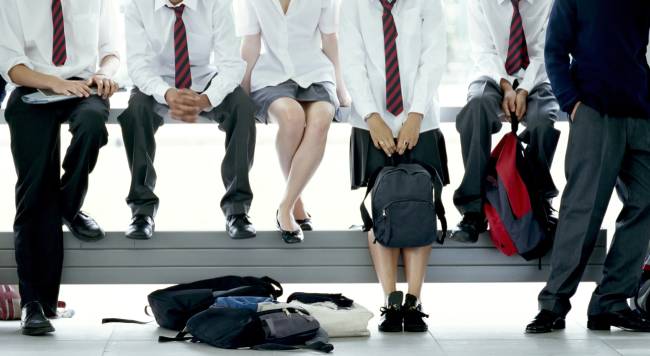In most middle and high schools, there is a dress code governing what students can and cannot wear. About 15 percent of American high schools and combined schools have strict dress codes requiring uniforms; however, other schools have many rules and regulations regarding clothing.
School Appropriate Dress Includes Decency and Modesty
In many school dress codes, teens are required to wear modest clothing to school, meaning clothes that cover their bodies and are decent. Modesty guidelines aim to minimize distraction and improve safety for students, but they are often open to interpretation.
Skirts and Shorts
In many schools, the “fingertip rule” determines the appropriate length of skirts and shorts. Socorro Independent School District, for instance, states, “The length of skirts, skorts, and shorts must extend below the student’s fingertips when extended at the sides.” Although many districts do not separate boy and girl guidelines, some do. Shorts, however, must be knee-length and worn above the hips for both boys and girls.
Tank Tops and Off-Shoulder Shirts
Many school guidelines prohibit spaghetti straps, strapless tops, muscle shirts, off-shoulder shirts, and tank tops, especially when they expose the entire shoulder or bra strap for girls and nipples or abdominal sides for boys. In Washington State, Chehalis Middle School does not allow students to wear tops with less than a two-finger width of shoulder coverage, while NCCSC stipulates that boys cannot wear shirts cut like “A-style undershirts or beach wear.”
Leggings
Several schools require students to wear Spandex leggings or yoga pants under skirts, long tops, or other clothing covering the bottom and genital area. According to the Warren Central School dress code, tights, leggings, or other types of hosiery must be accompanied by a top or dress that is fingertip length or longer.
Pajamas
Pajamas are often allowed for spirit days at school, but are discouraged otherwise due to their violation of other dress code rules, such as no baggy clothes or tank tops. When excluding pajama pants from acceptable attire, Southern High School lumps them in with other bottoms that may expose skin. Pajamas fall under the category of provocative clothing at Coast High School.
No Vulgarity
In general, schools do not allow clothing with vulgar or obscene words or graphics. In Edison High School’s definition of vulgarity, clothing depicting sexually suggestive expressions or actions, profanity, obscenity, drugs, alcohol, or tobacco, or degrading the integrity of individual groups, is vulgarity.
No Bare Midriffs
Boys wearing shirts cut off at the sides or girls wearing crop tops are often not allowed to display their bare midriffs. According to Salinas High School, the stomach and back must be fully covered without tugging or pulling.
Keep Undergarments Hidden
It is forbidden to wear bra straps under tank tops, underwear under baggy pants, or even undergarments that show through rips and holes in clothing. As part of the Oregon NOW Model Student Dress Code, visible underwear is prohibited, with the exception that undergarment waistbands and straps are not prohibited.
Necklines
There should be modesty in necklines. There are many schools that prohibit necklines that expose too much chest or cleavage. On campus, Carlisle School prohibits cleavage-revealing tops at all times.

Dress Codes and Safety
Several areas are addressed in school dress codes and graduation dress codes geared toward safety, including gang activity, theft, violence, and physical safety. They aim to eliminate clothing under which students can hide weapons and clothing that may make them more accident-prone. School property may also be damaged by some apparel. Items such as spiked jewelry and wallet chains may fall into this category.
No Gang-Related Clothing
Among these items are specific colors, head coverings such as do rags, jewelry, emblems, or graffiti. Any gang-related clothing is prohibited on school property or at school-sponsored events at James Logan High School. Depending on the gang activity in a particular region, the specific codes will vary.
No Overly Bulky Clothing
The purpose of this is to prevent students from hiding weapons in heavy coats, trench coats, or baggy clothing. During school hours, Thompson Middle School students are not allowed to wear “extremely baggy” clothing and must keep coats and zipped-hood sweatshirts in their lockers.
Tuck in Those Shirts
There are some schools that require shirts to be tucked in, but not all. In schools like The Saint Lucie County School District, shirts must be tucked in at the waist for all students. In some cases, this guideline is intended to prevent concealed weapons from being concealed in pants and skirt waistbands.
Appropriate Footwear
Commonly banned footwear includes anything without a back strap or that poses a fall risk. For safety reasons, such as responding appropriately to fire alarms or other emergencies, a school may not allow flip flops, platform shoes, or shoes with wheels.
Preventing Distractions With School Appropriate Dress
There are some types of apparel that are not allowed in school because they are considered a distraction.
Hats
Hats, scarves, and visors are often worn, but head coverings worn for religious reasons are not included. As part of their dress code, Martinez School District does not allow hats indoors, but they are legally obligated to allow hats during outdoor activities.
Sunglasses
During the learning process, sunglasses can interfere because it may be difficult for a student to see indoors and for a teacher to ensure the student is paying attention. Students are not permitted to wear sunglasses at Voorhees High School unless prescribed by a doctor.
Piercings
There are many schools that prohibit visible facial and body piercings, except for pierced ears. In some districts, extreme body piercings are prohibited because they may distract students or threaten their safety.
Following School Rules
You may disagree with school dress codes, but students who consistently violate them may be disciplined. Consequently, you should know your school’s dress code before the school year begins.
